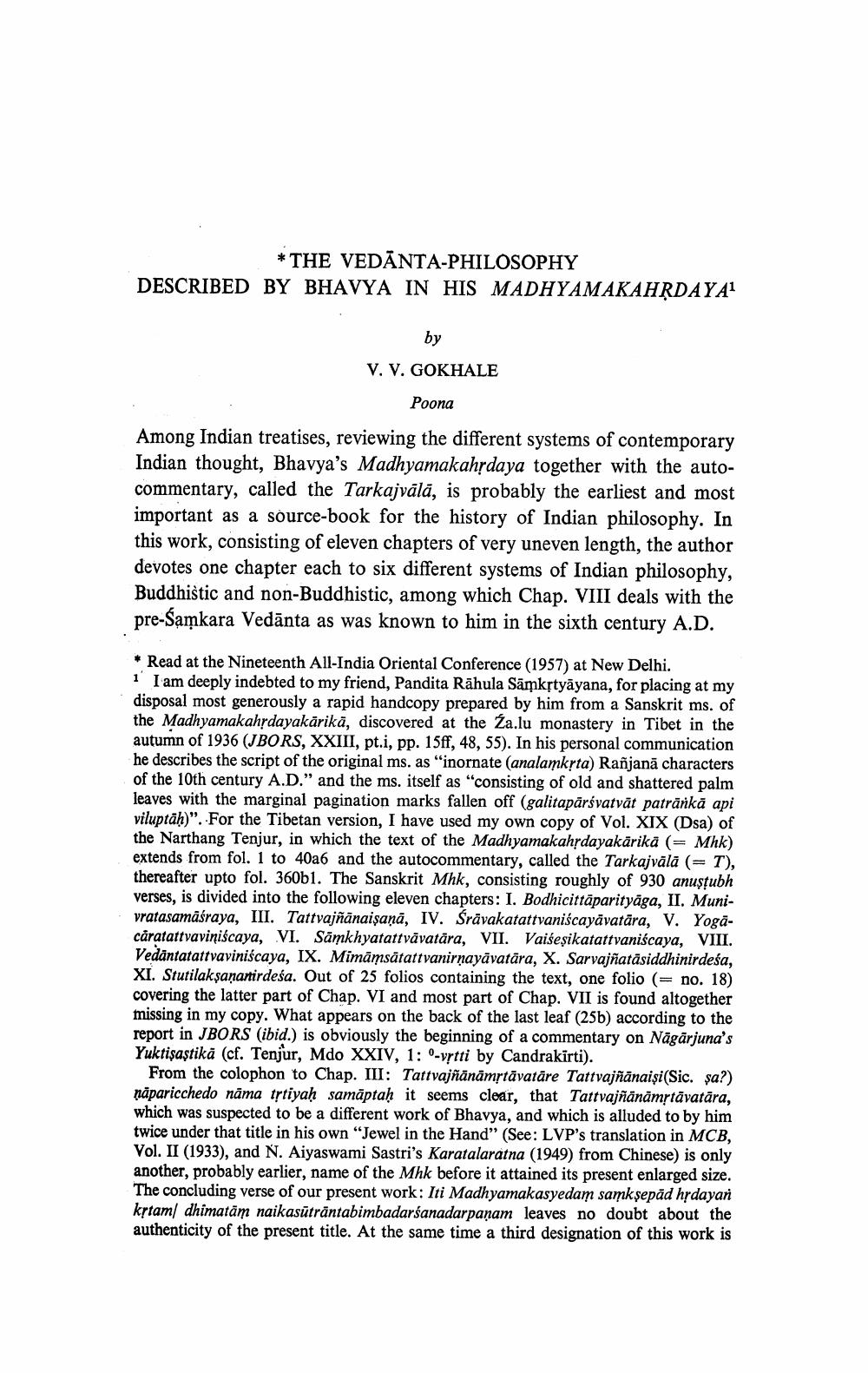Book Title: Vedanta Philosophy Described By Bhavya In His Madhyamaka Hrdaya Author(s): V V Gokhale Publisher: V V Gokhale View full book textPage 1
________________ * THE VEDĀNTA-PHILOSOPHY DESCRIBED BY BHAVYA IN HIS MADHYAMAKAHRDAYA by V. V. GOKHALE Poona Among Indian treatises, reviewing the different systems of contemporary Indian thought, Bhavya's Madhyamakahrdaya together with the autocommentary, called the Tarkajvālā, is probably the earliest and most important as a source-book for the history of Indian philosophy. In this work, consisting of eleven chapters of very uneven length, the author devotes one chapter each to six different systems of Indian philosophy, Buddhistic and non-Buddhistic, among which Chap. VIII deals with the pre-Samkara Vedānta as was known to him in the sixth century A.D. * Read at the Nineteenth All-India Oriental Conference (1957) at New Delhi. 1 I am deeply indebted to my friend, Pandita Rāhula Sārkstyāyana, for placing at my disposal most generously a rapid handcopy prepared by him from a Sanskrit ms. of the Madhyamakahrdayakārikā, discovered at the sa.lu monastery in Tibet in the autumn of 1936 (JBORS, XXIII, pt.i, pp. 15ff, 48, 55). In his personal communication he describes the script of the original ms. as "inornate (analamkrta) Rañjana characters of the 10th century A.D." and the ms. itself as "consisting of old and shattered palm leaves with the marginal pagination marks fallen off (galitapārsvatvāt patrārkā api viluptah)". For the Tibetan version, I have used my own copy of Vol. XIX (Dsa) of the Narthang Tenjur, in which the text of the Madhyamakahrdayakārikā (= Mhk) extends from fol. 1 to 40a6 and the autocommentary, called the Tarkajvälá (= T), thereafter upto fol. 360b1. The Sanskrit Mhk, consisting roughly of 930 anuştubh verses, is divided into the following eleven chapters: I. Bodhicittaparityāga, II. Munivratasamāśraya, III. Tattvajñānaişaņā, IV. Srävakatattvaniscayāvatāra, V. Yogacaratattvaviniscaya, VI. Sāmkhyatattvāvatāra, VII. Vaišeşikatattvaniscaya, VIII. Vedāntatattvaviniscaya, IX. Mimāņsātattvanirnayāvatāra, X. Sarvajñatāsiddhinirdeśa, XI. Stutilaksaņartirdeśa. Out of 25 folios containing the text, one folio (= no. 18) covering the latter part of Chap. VI and most part of Chap. VII is found altogether missing in my copy. What appears on the back of the last leaf (25b) according to the report in JBORS (ibid.) is obviously the beginning of a commentary on Nāgārjuna's Yuktişaştikā (cf. Tenjur, Mdo XXIV, 1: 0-yrtti by Candrakirti). From the colophon to Chap. III: Tattvajñānāmstāvatare Tattvajñānaişi(Sic. șa?) năparicchedo nāma trtiyaḥ samāptaḥ it seems clear, that Tattvajñānāmstāvatāra, which was suspected to be a different work of Bhavya, and which is alluded to by him twice under that title in his own "Jewel in the Hand" (See: LVP's translation in MCB, Vol. II (1933), and N. Aiyaswami Sastri's Karatalaratna (1949) from Chinese) is only another, probably earlier, name of the Mhk before it attained its present enlarged size. The concluding verse of our present work: Iti Madhyamakasyedam samkşepād hrdayan krtam/ dhimatām naikasūtrāntabimbadarśanadarpanam leaves no doubt about the authenticity of the present title. At the same time a third designation of this work isPage Navigation
1 2 3 4 5 6 7 8 9 10 11 12 ... 16
